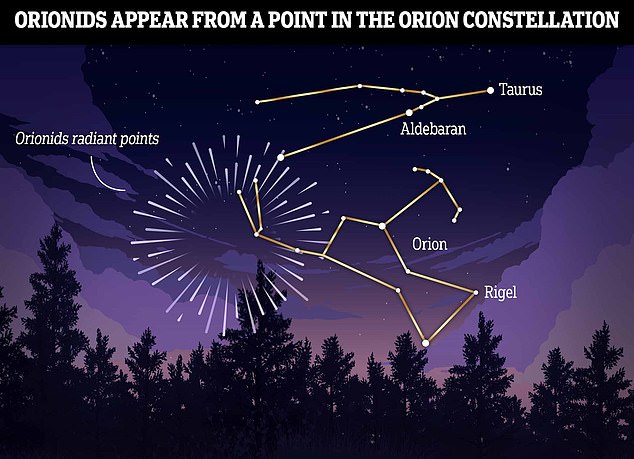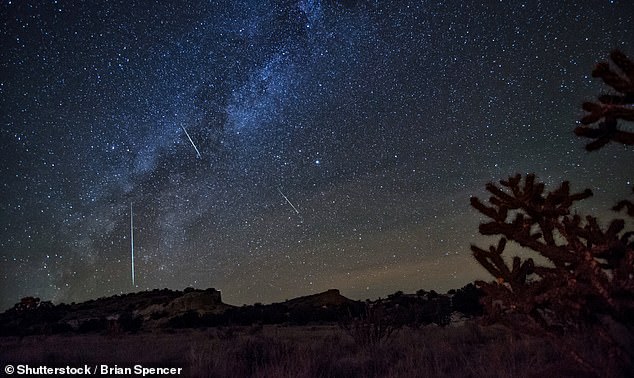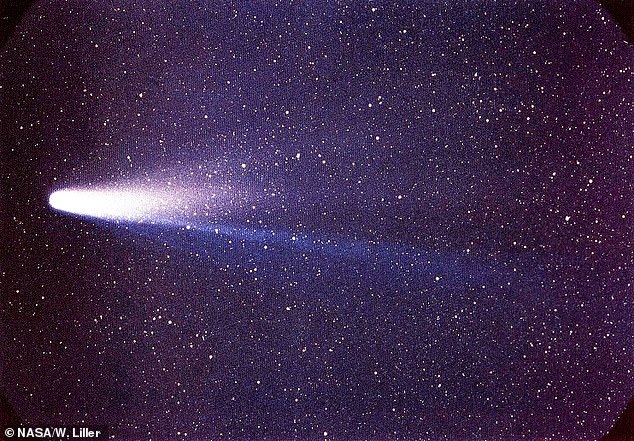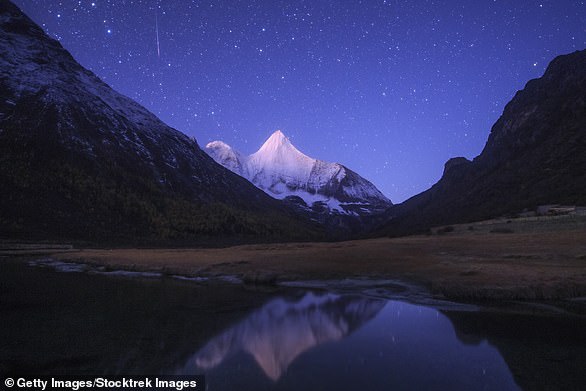Look up tonight! Orionid Meteor Shower peaks this evening with up to 25 shooting stars every hour – how and when to see it from the UK
>
If you enjoy stargazing, be sure to look up tonight because a “beautiful” meteor shower is about to light up the night sky.
The Orionids meteor shower, which occurs each fall when Earth passes through a stream of debris from Halley’s Comet, will reach its peak this evening with up to 25 meteors every hour.
It will be at its most wonderful between midnight and dawn tomorrow and Sunday.
To find orinoids, members of the public should find a location away from streetlights and other sources of light pollution.
Meteors can be seen with the naked eye, so there is no need for binoculars or a telescope, although a period of 20 minutes is recommended to allow the eye to adapt to the darkness.

The Orion radiant (the point in the sky where meteors appear to be coming from) is located in the constellation Orion, hence the name “Orion.”
At its peak, there could be more than 20 meteors flying overhead each hour, each traveling at speeds of up to 41 miles (66 kilometers) per second.
However, there are two main problems that sky watchers may face.
The first is the weather: clouds are expected to cover most of the UK tonight and early tomorrow morning, except for a few pockets in the south-east and east of England.
It’s a similar forecast for the early hours of Sunday, although this time it will be parts of southwest England, Ireland and Wales that may be able to look through the cloud.
The second problem is our satellite, which will be a growing crescent before it becomes a half moon, making its illumination close to 50 percent.
This means that conditions this year are not particularly favorable because the brighter moon makes it harder to spot meteors.
However, even if the Moon occults the summit, the Orionids will still stick around until November 7, so you may be able to catch them, albeit at a slightly lower rate.
Dr Daniel Brown, an astronomy expert at Nottingham Trent University, told MailOnline: ‘To observe them successfully, people need to make sure they find a good safe place away from any direct light, ideally with the sky being as dark as possible.’
‘Then take your time. The eyes need 20-30 minutes to fully adapt to the darkness and detect faint meteors. Just going out to the park to see them will not be enough, people must be patient.
“Make sure you choose a place where you can see a lot of the sky, not just Orion.” There is no need for any telescopes or binoculars. Meteors will streak across the entire sky.
According to the Royal Observatory in Greenwich, the Orionids are a “very special” display that reliably produces shooting stars that can be seen all over the world.
He added: “Meteors can be seen all over the sky, so it’s good to be in a wide open space where you can scan the night sky with your eyes.” But if you trace the paths taken by the meteors, they appear to originate from the constellation Orion.

Described as “one of the most beautiful showers of the year,” the phenomenon occurs every fall when Earth passes through a stream of debris left behind by Halley’s Comet.
Meteors, also known as shooting stars, come from the remains of comet particles and fragments of broken-up asteroids.
As comets orbit the Sun, the dust they emit gradually spreads in a dust trail around their orbits.
Every year, Earth passes through these trails of debris, which collide with our atmosphere and break up to form fiery, colorful streaks in the sky.
However, the events do not pose a threat to humans, as objects almost always burn up in our atmosphere before reaching the planet’s surface.
NASA says: “Orionids, which peak in mid-October each year, are considered one of the most beautiful rain showers of the year.”
‘Orion meteors are known for their brightness and speed. These meteors are fast, traveling at about 148,000 mph (66 km/s) into Earth’s atmosphere.
Fast meteors can leave glow “trains” (glowing bits of debris in the meteorite’s wake) that last for several seconds to minutes.
“Fast meteors can also sometimes become fireballs; look for long bursts of light when watching the Orionids meteor shower.
Halley’s Comet, which left behind sand-grain-sized particles that produce orids, comes around the inner solar system every 75 years or so.
It was last seen with the naked eye in 1986, and will not appear again until the summer of 2061.
In the meantime, we’re left to watch the meteor shower that comes from the “comet droppings” as it flies through the atmosphere.

Halley’s Comet on March 8, 1986. The space rock, which left behind grain-sized particles that produce the orionids, comes around the inner solar system every 75 years or so
The Royal Observatory Greenwich said: “Some people view the orionids as being very special because the meteorites are actually pieces of Comet 1P/Halley, commonly known as Halley’s Comet.”
“The comet swings close to Earth only once every 75 to 76 years, but this annual shower provides some compensation for those who might miss this once-in-a-lifetime event,” he added.
“As the comet follows its path around the Sun, it leaves a trail of small debris.
“Comet debris enters our planet’s atmosphere at a speed of about 41 miles per second, and evaporates from friction with the air, causing the streaks of light we call meteors.”
The Orionids are one of two showers produced by debris from Halley’s Comet. The other is Eta Aquarius in May.
After the Orionids, there are a few other meteor showers happening this year, including what NASA calls “the best meteor shower of the year” in the Geminids.
This occurs every year between December 4 and 20, and peaks between December 14 and 15.
The Geminid meteors, which are believed to increase every year, light up the night sky with up to 150 meteors per hour, says the Royal Observatory in Greenwich.
(Tags for translation)dailymail

